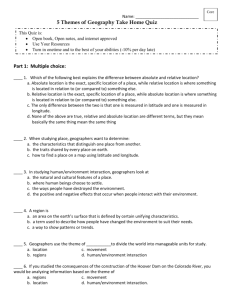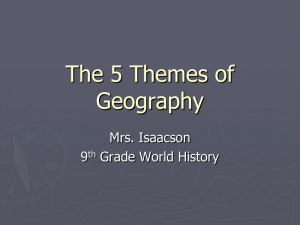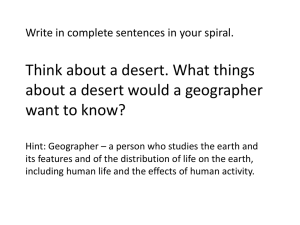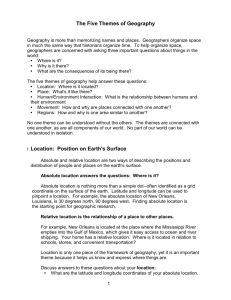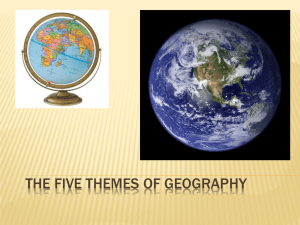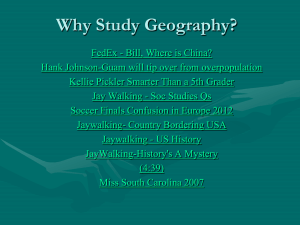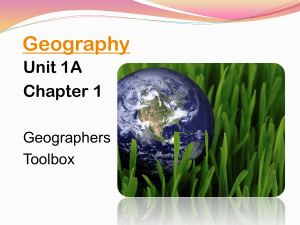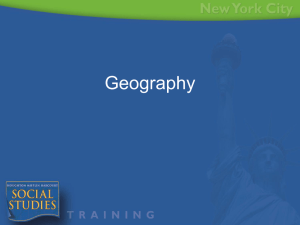5 Themes of Geography Practice
advertisement
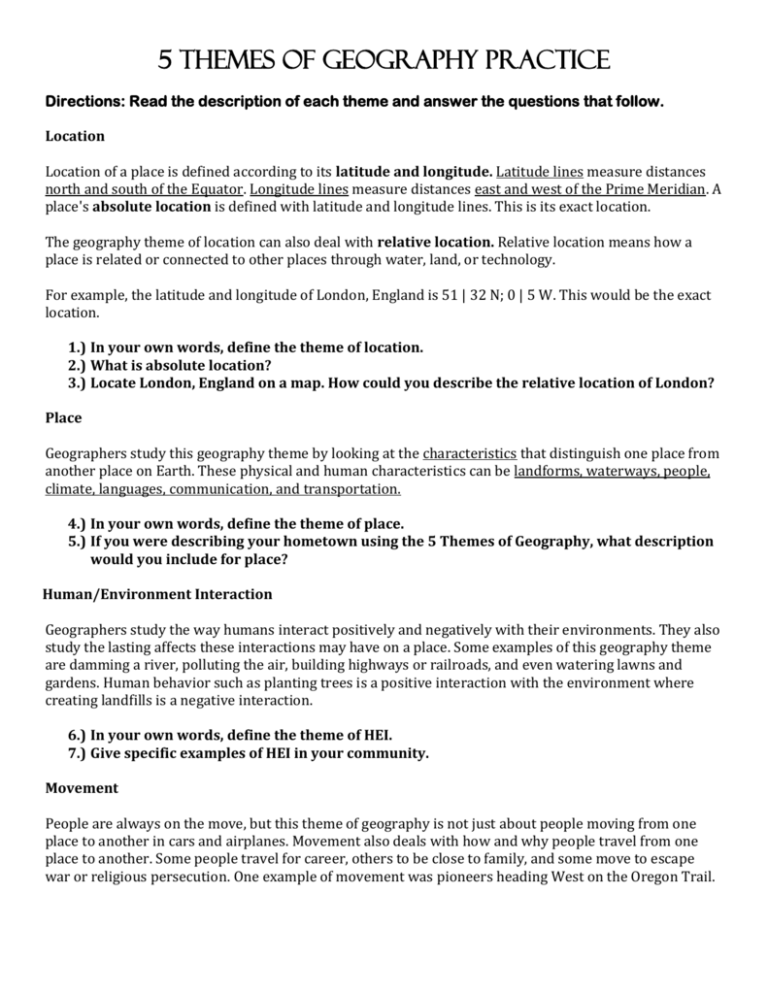
5 Themes of Geography Practice Directions: Read the description of each theme and answer the questions that follow. Location Location of a place is defined according to its latitude and longitude. Latitude lines measure distances north and south of the Equator. Longitude lines measure distances east and west of the Prime Meridian. A place's absolute location is defined with latitude and longitude lines. This is its exact location. The geography theme of location can also deal with relative location. Relative location means how a place is related or connected to other places through water, land, or technology. For example, the latitude and longitude of London, England is 51 | 32 N; 0 | 5 W. This would be the exact location. 1.) In your own words, define the theme of location. 2.) What is absolute location? 3.) Locate London, England on a map. How could you describe the relative location of London? Place Geographers study this geography theme by looking at the characteristics that distinguish one place from another place on Earth. These physical and human characteristics can be landforms, waterways, people, climate, languages, communication, and transportation. 4.) In your own words, define the theme of place. 5.) If you were describing your hometown using the 5 Themes of Geography, what description would you include for place? Human/Environment Interaction Geographers study the way humans interact positively and negatively with their environments. They also study the lasting affects these interactions may have on a place. Some examples of this geography theme are damming a river, polluting the air, building highways or railroads, and even watering lawns and gardens. Human behavior such as planting trees is a positive interaction with the environment where creating landfills is a negative interaction. 6.) In your own words, define the theme of HEI. 7.) Give specific examples of HEI in your community. Movement People are always on the move, but this theme of geography is not just about people moving from one place to another in cars and airplanes. Movement also deals with how and why people travel from one place to another. Some people travel for career, others to be close to family, and some move to escape war or religious persecution. One example of movement was pioneers heading West on the Oregon Trail. Geographers also study how products and resources are transported from one region or place to another. This includes manufactured products, crops, and oil. For example, a tractor-trailer delivering oranges from Florida to New York, or a boat delivering a shipment of coffee from Africa to Europe. In addition, movement of ideas is also studied. With the advent of technology such as the phone and internet, ideas such as fashion, fads, music and philosophical ideologies are exchanged rapidly from all areas of the globe. Languages also evolve and change based on influence from outside ideas and other languages. 8.) In your own words, define the theme of Movement. 9.) Give specific examples of movement in your community. Regions A region is a unit on the earth's surface that has unifying characteristics such as climate or industry. These characteristics may be human, physical, or cultural. Not only do geographers study characteristics, but they also study how regions around the world may change over time. There are three types of regions: perceptual, functional, and formal. Perceptual regions may change. These are based on people perceptions of the region. For example, in the United States, we commonly identify the South as a perceptual region. Those states that are located in the south-eastern part of the United States have similar climates and grow similar crops, in addition many people who live there have a "southern" accent. They share a similar geographic location within the country and a similar history. These are characteristics that help unify this area of land that is considered a region. A functional region is a region that serves a function. Places within in an area are linked together through a common factor. For example, a city and its surrounding suburbs creates a functional region. People generally move to the suburbs if they have a job in the city. A school district is another functional region. Students who live in different neighborhoods within a city attend the same school district. The school district links the different areas together. Another example is a local news channel. Areas that all can view the same local news channel constitutes a functional region because they depend on the same channel to report accurate and current news. A formal region is an area with uniform characteristics. Formal regions include states/countries and continents. Think of these as the boundaries that aren’t going to move easily. Asia will always be Asia. North America will always be North America. It would be extremely hard for someone to move the boundaries of these continents. 10.) 11.) 12.) 13.) In your own words, define the theme of region. Give an example of a functional region in your community. Give an example of a formal region. Give an example of a perceptual region.
